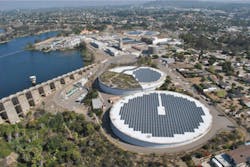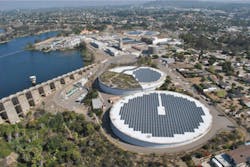Water Infrastructure: Time to Turn on the Private Investment Tap?
By Manju Chandrasekhar
Scarcity is big news in the water industry today. But it's not just water that's in short supply. While climate is the culprit behind many regional shortages, the impacts of a drought in public funding are beginning to emerge across the entire country. Estimates for the cost of repairing and updating U.S. drinking water infrastructure alone range from Environmental Protection Agency's (EPA) $500-billion projection by 2022 to American Water Works Association's (AWWA) estimate that will top $1 trillion in the next 25 years.
Water utilities have joined the chorus in calling for more public investment to save critical infrastructure -- notably supporting the passage of the Water Infrastructure Finance and Innovation Act (WIFIA), with a funding commitment for the first year pilot of $40 million ($20 million each for EPA and U.S. Army Corps of Engineers), which would ramp up to $100 million by the fifth year. While this is a good start, it is a drop in the bucket when pitted against the magnitude of the problem and therefore cannot be the only answer considered.
Utilities looking for funding to compensate for tax and revenue shortfalls can find proven best practices in a new report from ARCADIS, a global natural and built asset consultancy. The Global Infrastructure Investment Index (GIII) study ranks 41 countries worldwide on how attractive they are for private investment, pointing to several ways in which the U.S. can improve its appeal to private investors.
The study also shows that the U.S. presents some unique challenges to be addressed before we see substantial deployment of private capital in infrastructure. The following ideas and insights, however, can help planners create the conditions necessary to bring about a much-needed shift in the traditional domestic financing model.
Create Conditions That Set the Stage
The fundamentals that drive business need to be in place. The following are examples of ideal conditions necessary for attracting private investment:
- Economic strength. This includes strong gross domestic product (GDP) per capita and long-term GDP growth. Fortunately, and despite some unevenness, the U.S. economy continues to have a better outlook for supporting growth than many other mature economies globally.
- Low risk. This is as much about stability and predictability as the risk itself. That means that risks, such as inflation, labor, protections for investors, and even terrorism threats, all feed into investor risk assessments. In the U.S., the risks have less to do with security and more to do with regulatory sustainability, permitting risk and project scale.
- Supportive financial infrastructure. The many factors that can erode return for investors need to be in check, including tax rates on profits, financial credit rating, availability of insurance, and perhaps most significantly, deep and liquid financial markets.
- Business-friendly environment. In the U.S., some of the proper conditions are in place, but many critical factors still need to be addressed. Investors want to see a clear program, timetable and plan that show how they will benefit from their investment. According the GIII report, "There is nothing more powerful than a government saying, ‘This is the plan, and we are going to stick to it.'"
In other words, to attract investment, we need to put the right elements in place to support private financing structures. This sounds easy but involves a fundamental change in the way the whole country approaches infrastructure financing.
Create the Value Proposition
As long as consumers broadly maintain the perception that an essential service like water is virtually "free," then attracting private investment in water infrastructure will be an uphill battle. This systemic undervaluation of water needs to be fixed first to create the return-on-investment equation that investors require.
At the same time, a dependency on rates and taxes to achieve full cost-recovery may not always be the answer either, as public utilities may occasionally be missing opportunities to devolve and share risk with private investors. We need to shift our thinking and see water infrastructure not simply as a source of water, but as a source of economic prosperity. Envisioning money flowing through those pipes will change these assumptions. If we tap into the true value of water, we tap one of the richest aquifers: private investment.
Of course, it isn't a matter of setting new rates for water and watching private funding roll in. Addressing market challenges will go far to help establish the right conditions needed to make private investment a reliable source of funding. The following are examples of viable techniques for attracting private investment:
1. Scale funding resources to meet the need. Right now, there is some buzz about WIFIA, which would offer low-interest federal loans and guarantees for significant water projects structured as public-private partnerships (PPP).
WIFIA has the potential to open up more water projects to PPP financing. However, under WIFIA as it stands now, projects that tap into these loans can only fund up to 49 percent of their costs over $20 million (or $5 million for projects serving populations fewer than 25,000).
By these rules, these projects can't simultaneously tap into municipal tax-exempt bond financing for the balance or receive state funding. While the idea is to incentivize private investment, if this move does not effectively provide a sufficient and competitive offset in the cost differential between tax-exempt municipal debt and a privately financed project with WIFIA, then will utilities want to fund their projects this way?
In addition, current WIFIA funding needs to be considered only a first step. First-year spending is limited to $40 million ($20 million each for EPA and U.S. Army Corps of Engineers) -- compared to the Transportation Infrastructure Finance and Innovation Act's start with $80 million in 1999. Leveraging the credit assistance provided by WIFIA against private equity capital is expected to generate $200 million in additional debt financing in the first year -- a good start, but not the complete answer.
2. Share the risk with private investors. It's also important to equitably share risks with private investors. It makes more sense to use public funding strategically in areas where it can produce the most impact. Deploying public sources of capital against risks that the public sector is best suited to manage, such as upfront permitting risk, will create conditions that are more attractive for private investment in the project.
3. Make programs large enough to attract investors. While the level of new financing support may be insufficient to fund the nation's broader needs right now, the other problem of scale pertains to many municipal projects being too small to generate sufficient interest among private investors. Our experience with these investors suggests that projects under a certain threshold value (considered at least $100 million for this discussion) are generally of an insufficient scale to leverage private sector competitiveness and generate the returns that these investors require.
For example, if one considers the efforts invested toward a private financing structure of a $50-million water project as similar to those invested toward a competing infrastructure project of $500 million with potentially greater aggregate returns, then it's no surprise which one they will want to pursue.
Best practices in other countries have demonstrated that, while the step change needed to scale up projects to make them attractive for investors can be challenging, it is certainly far from impossible. The UK, for example, created a limited number of private companies to manage water resources. Regular investment surveys help the UK maintain a strong position as an investment vehicle. In a large country like the U.S., we have to wonder: what would change when municipalities are not managing their water and wastewater finances?
One should also consider the potential of infrastructure ‘clearing houses' and/or exchanges designed to act as a catalyst in facilitating effective structuring and procurement of projects. These entities seek to achieve appropriateness through their projects. Best practice from the UK and Canada, where agencies like Infrastructure UK exist, point to some success from the pooling concept -- not just of projects, but potentially expertise and resources as well.
4. Use revenue from real-estate development to pay for resiliency infrastructure. Seeking to replicate and improve upon the model used to develop Battery Park City, the New York City Economic Development Corporation engaged ARCADIS to assess the feasibility of using development revenue from a multi-purpose levee that would protect a 1.3-mile area along the eastern edge of Southern Manhattan against flooding and storm surges.
This strategy also creates economic activity in the form of jobs and taxes that accompany it. However, as this model is based on the land scarcity and associated value-premium of Manhattan, it is perhaps not universally applicable elsewhere. To make this work, the project needs to start with the potential to tap exceptional real-estate values and density.
The GIII study notes that countries with the right political environment, economic fundamentals and attractively structured infrastructure strategies have opened up the private investment pipeline. In the U.S., we are making first attempts and trying new strategies to address years of underfunding.
Experience worldwide has shown that tapping into private finance requires a whole new mindset for structuring infrastructure financing. We need to think of water as an economic engine with value, but we also need to avoid a 100-percent transfer of all risk to the private sector.
The need is huge, but the potential is there and ideas abound. Now it's time to be bold enough to invite the ideas that the private sector brings with it.
About the Author: Manju Chandrasekhar is a vice president at ARCADIS in New York, where his responsibilities include leading business development and client-relationship management activities of the firm's financial institution clients across the Americas. He leads ARCADIS' efforts to establish itself in an advisory capacity at the executive level, with a focus on financiers, developers, owners and operators of infrastructure and real estate assets.
More WaterWorld Current Issue Articles
More WaterWorld Archives Issue Articles

